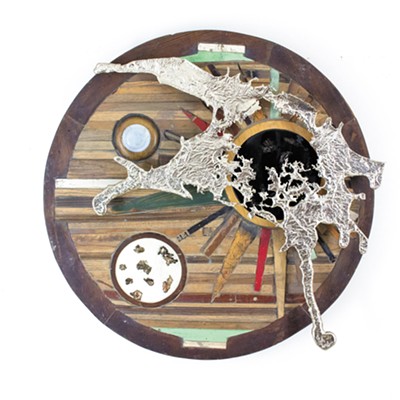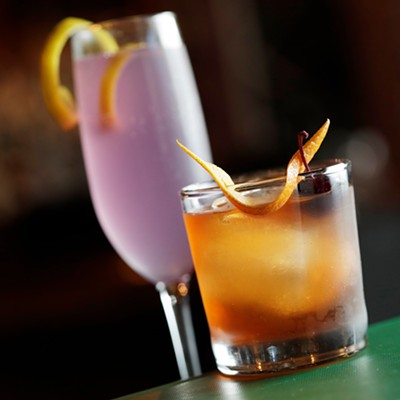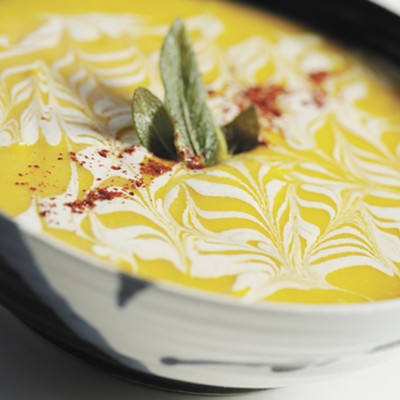Raw Delights
[
{
"name": "Broadstreet - Instory",
"insertPoint": "5",
"component": "25846487",
"requiredCountToDisplay": "5"
},{
"name": "Broadstreet - Instory",
"insertPoint": "10",
"component": "25846487",
"requiredCountToDisplay": "10"
},{
"name": "Broadstreet - Instory",
"insertPoint": "15",
"component": "25846487",
"requiredCountToDisplay": "15"
},{
"name": "Broadstreet - Instory",
"insertPoint": "20",
"component": "25846487",
"requiredCountToDisplay": "20"
}
]
by CARRIE SCOZZARO & r & & r &
& lt;span class= "dropcap " & W & lt;/span & asabi is addictive. It burns so good, that pale green Japanese horseradish paste, looking like guacamole but not (as we've all learned the hard way). There is nothing like the buzz of a wasabi burn, like ice cream brain-freeze in reverse. Even better when coupled with tekka maki sushi -- chunks of raw tuna and barely warm sticky rice encased in nori seaweed dipped in thick wasabi sauce, a protein high unobtainable from mere cooked flesh.
Most addicts learn to work within the confines of their cravings: homemade shrimp tempura (store-bought batter and not as hard to make as you think); closing your eyes and pretending the supermarket stuff is good enough; or hauling down to your favorite Japanese restaurant. If you live in the boonies as I do, the latter option is the best-tasting but sometimes the least convenient. So when a new Japanese restaurant opens nearby, the buzz is as palpable as the habit-forming wasabi burn.
When Syringa Japanese Caf & eacute; and Sushi Bar opened last April, it came on the heels of the closure of my former supplier, Momiji, in Post Falls, a reasonable driving distance from Boonieville. Imagine my delight in seeing Kenta Nishimori, Momiji's former sushi chef, behind the counter at Syringa. On my first visit, he suggested the dragon roll ($11), a kicked-up-a-notch tempura roll, topped with wasabi and sirachi chili sauce, that lived up to its name. The 7 Spice Duck Tataki ($8) was melt-in-your-mouth tender, served on saut & eacute;ed onion salad with an almost-too-salty soy reduction.
Like many fellow diners that night, I ate alone, comfortably. The sushi bar seats six and it's not uncommon for chef and owner Viljo Basso to cook up something special, like small plates of crispy-warm outside/cool inside tuna steak bites. Every time I've been there I've recognized familiar faces, like the fellow from my former church perched always on the same stool. It's all about the food. (Nice to know I'm not alone in my addiction.)
That's not to say there's no atmosphere at Syringa; there is. Earth-toned walls, hip artwork -- koi, Chinese dragons, live bamboo arrangements on every table, linen napkins and ebony-colored chopsticks (not the kind you snap apart yourself and hope are splinter-free).
There is a bistro feel to Syringa, with traditional Japanese dishes alongside specialties bearing moderate to heavy European accents. In addition to tempura, yakisoba and udon noodle dishes, gyoza, sukiyaki, and the assorted sashimi, sushi and so on, Syringa surprises with eggplant ravioli ($16) and free-range beef tenderloin with Dungeness crab ($22). Soup was miso or Kabotcha squash, a nutty bright-orange puree topped with a tangy swirl-pattern of cr & egrave;me fraiche ($3), and salad options included spinach ($6) with sliced almonds, bacon crumbles, thin-slice mushrooms and grape tomatoes, and a clever star-shaped garnish of carrots.
These are two minor examples of Basso's finesse at the finer points of presentation, which reflects his 16-year classical training: from Coeur d'Alene's Takara to the Western Culinary Institute in Portland, to Seattle. There he worked at top-rated restaurants including Cascadia and Rover's. After returning to Takara, Basso and his wife, Autumn, created Syringa, named for the state flower. The result is fresh, flavorful and inventive food. They use no MSG, and everything, especially the seafood, tasted off-the-docks fresh.
On my next visit, my companion said, "I feel good about eating here. It's good and healthy." Still, she was delighted to hear about the cr & egrave;me brulee, which we later "split" (though I think she got the larger share of it). Even this humble dessert was excellent, with its telltale black flecks of real vanilla bean.
For dinner, we split Basso's Chilean sea bass misozuke ($16), a plentiful whitefish steak with a sweet glaze served atop roasted vegetables: whole-clove garlic, onion, eggplant, squash, broccoli. Although again a bit salty to my taste (our server attributed it to the three-day miso marination process), it reheated well the next day, when the saltiness seemed less apparent.
The wine list was abundant, but the day felt warm enough to warrant chilled cocktails ($6): a Keith Richards (sake, Rockstar energy drink and apple juice) and the Kenta Seabreeze (plum wine, Sprite and sake). Other choices include domestic and imported beers and an extensive sake list, such as the fuller-bodied Junmai style, referring to "pure" rice-wine with no starches or brewer's alcohol added. Keith Richards had a surprising kick so I switched to tea, served by the cup -- a mix of green tea and brown rice that was smooth and fragrant.
We had to have something from the sushi bar, of course, but couldn't decide on just one offering. Our server, who was delightfully knowledgeable and attentive, suggested the Rainbow ($12) -- a California roll (with real Dungeness) topped with a sampling of ebi shrimp, both maguro and albacore tuna, mackerel and salmon. It's not on the menu, but our server said people custom-order all the time, no problem. Figuring we'd take home whatever we couldn't eat, we also tried the Northwest rolls ($7), saut & eacute;ed wild mushrooms with tempura green beans and smoked salmon. Delightful.
It was a splurge -- we could have stopped at the sea bass -- but the prices were extremely affordable and the food oh-so-hard-to-resist. Even on the ride home to Boonieville, my to-go box was too much temptation. Predictably, the sushi didn't make it 10 minutes up the road before I happily polished off the remaining pieces. At least it's a healthy addiction.
& lt;span class= "dropcap " & W & lt;/span & asabi is addictive. It burns so good, that pale green Japanese horseradish paste, looking like guacamole but not (as we've all learned the hard way). There is nothing like the buzz of a wasabi burn, like ice cream brain-freeze in reverse. Even better when coupled with tekka maki sushi -- chunks of raw tuna and barely warm sticky rice encased in nori seaweed dipped in thick wasabi sauce, a protein high unobtainable from mere cooked flesh.
Most addicts learn to work within the confines of their cravings: homemade shrimp tempura (store-bought batter and not as hard to make as you think); closing your eyes and pretending the supermarket stuff is good enough; or hauling down to your favorite Japanese restaurant. If you live in the boonies as I do, the latter option is the best-tasting but sometimes the least convenient. So when a new Japanese restaurant opens nearby, the buzz is as palpable as the habit-forming wasabi burn.
When Syringa Japanese Caf & eacute; and Sushi Bar opened last April, it came on the heels of the closure of my former supplier, Momiji, in Post Falls, a reasonable driving distance from Boonieville. Imagine my delight in seeing Kenta Nishimori, Momiji's former sushi chef, behind the counter at Syringa. On my first visit, he suggested the dragon roll ($11), a kicked-up-a-notch tempura roll, topped with wasabi and sirachi chili sauce, that lived up to its name. The 7 Spice Duck Tataki ($8) was melt-in-your-mouth tender, served on saut & eacute;ed onion salad with an almost-too-salty soy reduction.
Like many fellow diners that night, I ate alone, comfortably. The sushi bar seats six and it's not uncommon for chef and owner Viljo Basso to cook up something special, like small plates of crispy-warm outside/cool inside tuna steak bites. Every time I've been there I've recognized familiar faces, like the fellow from my former church perched always on the same stool. It's all about the food. (Nice to know I'm not alone in my addiction.)
That's not to say there's no atmosphere at Syringa; there is. Earth-toned walls, hip artwork -- koi, Chinese dragons, live bamboo arrangements on every table, linen napkins and ebony-colored chopsticks (not the kind you snap apart yourself and hope are splinter-free).
There is a bistro feel to Syringa, with traditional Japanese dishes alongside specialties bearing moderate to heavy European accents. In addition to tempura, yakisoba and udon noodle dishes, gyoza, sukiyaki, and the assorted sashimi, sushi and so on, Syringa surprises with eggplant ravioli ($16) and free-range beef tenderloin with Dungeness crab ($22). Soup was miso or Kabotcha squash, a nutty bright-orange puree topped with a tangy swirl-pattern of cr & egrave;me fraiche ($3), and salad options included spinach ($6) with sliced almonds, bacon crumbles, thin-slice mushrooms and grape tomatoes, and a clever star-shaped garnish of carrots.
These are two minor examples of Basso's finesse at the finer points of presentation, which reflects his 16-year classical training: from Coeur d'Alene's Takara to the Western Culinary Institute in Portland, to Seattle. There he worked at top-rated restaurants including Cascadia and Rover's. After returning to Takara, Basso and his wife, Autumn, created Syringa, named for the state flower. The result is fresh, flavorful and inventive food. They use no MSG, and everything, especially the seafood, tasted off-the-docks fresh.
On my next visit, my companion said, "I feel good about eating here. It's good and healthy." Still, she was delighted to hear about the cr & egrave;me brulee, which we later "split" (though I think she got the larger share of it). Even this humble dessert was excellent, with its telltale black flecks of real vanilla bean.
For dinner, we split Basso's Chilean sea bass misozuke ($16), a plentiful whitefish steak with a sweet glaze served atop roasted vegetables: whole-clove garlic, onion, eggplant, squash, broccoli. Although again a bit salty to my taste (our server attributed it to the three-day miso marination process), it reheated well the next day, when the saltiness seemed less apparent.
The wine list was abundant, but the day felt warm enough to warrant chilled cocktails ($6): a Keith Richards (sake, Rockstar energy drink and apple juice) and the Kenta Seabreeze (plum wine, Sprite and sake). Other choices include domestic and imported beers and an extensive sake list, such as the fuller-bodied Junmai style, referring to "pure" rice-wine with no starches or brewer's alcohol added. Keith Richards had a surprising kick so I switched to tea, served by the cup -- a mix of green tea and brown rice that was smooth and fragrant.
We had to have something from the sushi bar, of course, but couldn't decide on just one offering. Our server, who was delightfully knowledgeable and attentive, suggested the Rainbow ($12) -- a California roll (with real Dungeness) topped with a sampling of ebi shrimp, both maguro and albacore tuna, mackerel and salmon. It's not on the menu, but our server said people custom-order all the time, no problem. Figuring we'd take home whatever we couldn't eat, we also tried the Northwest rolls ($7), saut & eacute;ed wild mushrooms with tempura green beans and smoked salmon. Delightful.
It was a splurge -- we could have stopped at the sea bass -- but the prices were extremely affordable and the food oh-so-hard-to-resist. Even on the ride home to Boonieville, my to-go box was too much temptation. Predictably, the sushi didn't make it 10 minutes up the road before I happily polished off the remaining pieces. At least it's a healthy addiction.




















